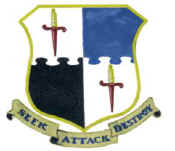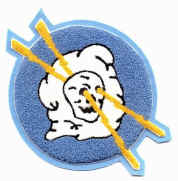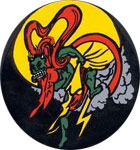52nd Fighter Group
Two Army Air Force fighter groups in World War II had the unique and distinct opportunity of transitioning to
and flying a famous British aircraft, the Supermarine Spitfire, throughout the Mediterranean theatre. Those two groups
were the 31st (Squadrons 307th, 308th, 309th) and 52nd Fighter Groups (Squadrons 2nd, 4th, 5th), and this is their history.
Introduced to the Spitfire upon their arrival in the United Kingdom in the summer of 1942, they participated in
Operation Torch, then swept through the Mediterranean theatre in support of Allied forces. Distinguishing themselves
with their performance in the Spitfire, they made major contributions to the war effort in that aircraft until they
transitioned to the P-51 Mustang in the spring of 1944
Source for following: http://www.web-birds.com/
| Squadron Insignia: | 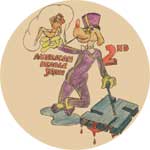
'The American Beagle Squadron' |
|
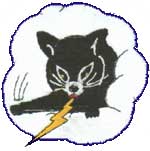
'Spitten Kittens' |
|||
| 2nd FS |
This 4th FS patch is of post war origin above is its predecessor. This posted design depicts an Okinawan wind god and came into being when the 4th was
transferred to that island to the 347thFG in February 1947 |
5th FS | ||||
| Plane Identification: | QP | WD | VF | |||
| Call Sign Gonad |
| Air Forced Assigned To: | 8th AF (July '42) | |
| 12th AF (Sept 14th '42) | ||
| 15th AF (May '44 - end WWII) | ||
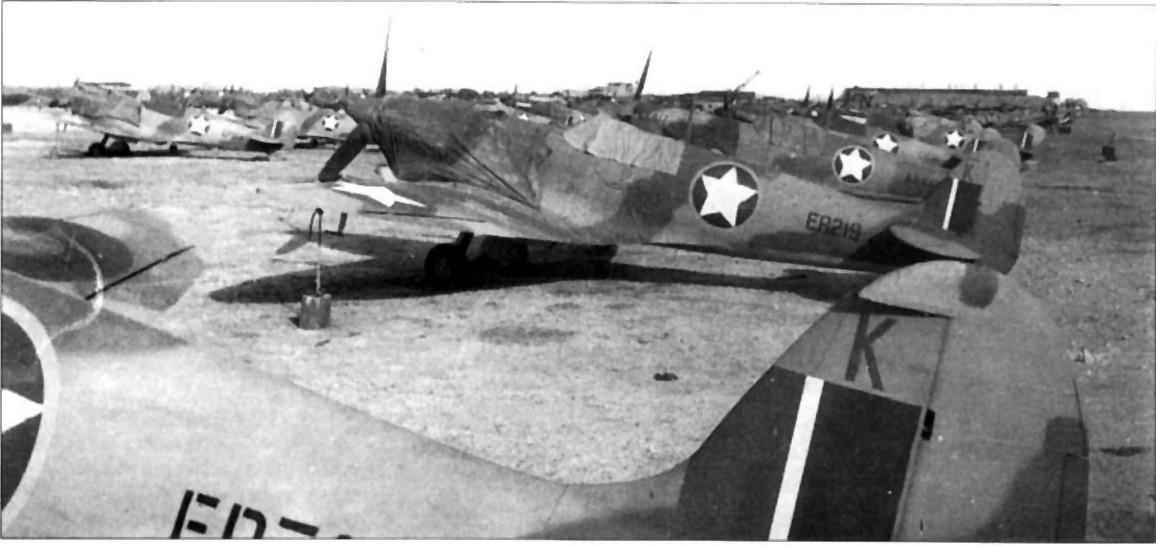 |
274 Spitfire V where used by USAAF 12AF by the 31st and the 52nd Fighter Groups during campaigns in Tunisia and Sicily these where photographed at North Front Gibraltar | |
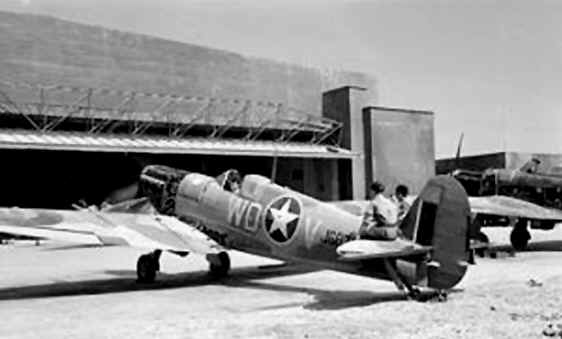 |
RAF fitters running a test on an overhauled Rolls Royce Merlin
engine installed in a Supermarine Spitfire Mark VC (possibly JG873)
undergoing repair at No.144 Maintenance Unit, Maison Blanche, Algeria.
The aircraft still bears the markings of the 4th Fighter Squadron/52nd
Fighter Group, 12th USAAF, with whom it formerly operated. |
| Stations Flown From: |
Northern Ireland, Jul 13 1942 MONDAY, 13 JULY 1942, EUROPEAN THEATER OF OPERATIONS (ETO, 8th Air Force): HQ 52d Fighter Group arrives at Eglinton, Co. Derry, Ireland from the US. WEDNESDAY, 19 AUGUST 1942, ETO (8th AF): Mission 2: 22 of 24 B-17s bomb Abbeville/Drucat Airfield, France at 1032-1040 hours; 3 B-17s are damaged; 6 B-17s fly a diversion and 2 airmen are WIA. This mission is flown to occupy the Luftwaffe and prevent them from opposing an invasion by over 5,000 Allied troops, mostly Canadians, who raid Dieppe, France. 123 Spitfire Mk Vs of the 31st Fighter Group support the raid on Dieppe and claim 1-1-5 Luftwaffe aircraft with the loss of 8 Spitfires (4 pilots are MIA); 2d Lieutenant Samuel F Junkin Jr of the 309th Fighter Squadron, 31st Fighter Group, flying a Spitfire Mk V in support of the amphibious raid on Dieppe, shoots down a German fighter, this being the first aerial victory won by an 8th Air Force fighter pilot flying from the UK. Units arriving in England from the US: HQ 1st Bombardment Wing at Brampton Grange; 353d and 419th Bombardment Squadrons (Heavy), 301st Bombardment Group (Heavy), at Chelveston with B-17s (first mission is 2 Oct). 2d, 4th and 5th Fighter Squadron, 52d Fighter Group arrive at Eglinton, Co Derry, Ireland from the US (squadrons will be equipped with Spitfire Mk Vs and 2d and 4th Fighter Squadrons will fly their first mission on 27 Aug; 5th Fighter Squadron will not fly missions). |
|
|
Goxhill, England, Aug 26 - Oct 1942 WEDNESDAY, 26 AUGUST 1942, ETO (8th AF): Unit moves in England: HQ 52d Fighter Group and 2d, 4th and 5th Fighter Squadrons from Eglinton, Ireland to Goxhill with Spitfires; 27th Fighter Squadron, 1st Fighter Group, stops operating from Reykjavik, Iceland with P-38s and moves to High Ercall. TUESDAY, 8 SEPTEMBER 1942, EUROPEAN THEATER OF OPERATIONS (ETO, 8th Air Force): The "Joint British American Directive on Day Bomber Operations Involving Fighter Cooperation" is issued; worked out between Major General Carl Spaatz and the RAF, it consigns night bombing to the RAF and day bombing to the Eighth Air Force; the purpose is to achieve continuity in the bombing offensive and secure RAF fighter support for US bombers; General Spaatz orders all tactical operations to give way to activity in support of Operation TORCH (plan for Allied landings in N and NW Africa in Nov 42); processing of units of the newly created Twelfth Air Force destined for N Africa takes priority over combat operations for the present. In England, HQ 3d Photographic Group arrives at Membury from the US; 342d and 414th Bombardment Squadrons (Heavy), 97th Bombardment Group (Heavy), move from Grafton Underwood to Polebrook with B-17s. MONDAY, 14 SEPTEMBER 1942, EUROPEAN THEATER OF OPERATIONS (ETO) 8th Air Force: After the transfer of the combat unit to the Twelfth Air Force (see below), the combat units assigned to the Eighth are: HQ 3d Photographic Group and 5th, 12th, 13th and 14th Photographic Squadrons and 15th Photographic Mapping Squadron with F-4s, F-5s and B-17Fs; HQ 4th Fighter Group and 334th, 335th and 336th Fighter Squadrons at Steeple Morden with Spitfire Vs; HQ 44th Bombardment Group (Heavy) and 66th, 67th and 68th Bombardment Squadrons (Heavy) at Cheddington with B-24s; HQ 67th Observation Group and 12th, 107th, 109th and 153d Observation Squadrons at Membury with no aircraft; HQ 91st Bombardment Group and 322d, 323d, 324th and 401st Bombardment Squadrons (Heavy) at Kimbolton with B-17Fs; HQ 92d Bombardment Group (Heavy) and 325th, 326th, 327th and 407th Bombardment Squadrons (Heavy) at Bovingdon with B-17Fs; HQ 93d Bombardment Group (Heavy) and 328th, 329th, 330th and 409th Bombardment Squadrons (Heavy) at Alconbury with B-24Ds; HQ 303d Bombardment Group (Heavy) and 358th, 359th, 360th and 427th Bombardment Squadrons (Heavy) at Molesworth with B-17Fs; HQ 305th Bombardment Group (Heavy) and 364th, 365th, 366th and 422d Bombardment Squadrons (Heavy) at Grafton Underwood with B-17Fs; and HQ 306th Bombardment Group (Heavy) and 367th, 368th, 369th and 423d Bombardment Squadrons (Heavy) at Thurleigh with B-17Fs. Twelfth Air Force: HQ Twelfth AF, XII Fighter Command, XII Air Force Services Command, and XII Bomber Command are attached to corresponding units of the Eighth AF in the UK; The Eighth subsequently handles the buildup of the Twelfth by assigning a large number of its own units to the new AF (appropriately dubbed JUNIOR) and supervises its training. The following combat units are transferred from the Eighth to Twelfth Air Force: HQ 1st Fighter Group and 27th, 71st and 94th Fighter Squadrons at Ibsley and High Ercall with P-38Fs; HQ 14th Fighter Group and 48th and 49th Fighter Squadrons at Atcham with P-38Fs; HQ 31st Fighter Group and 307th, 308th and 309th Fighter Squadrons at Westhampnett with Spitfire Vs; HQ 52d Fighter Group and 2d, 4th and 5th Fighter Squadrons at Goxhill with Spitfire Vs; HQ 60th Troop Carrier Group and 10th, 11th, 12th and 28th Troop Carrier Squadrons at Aldermaston with C-47s; HQ 64th Troop Carrier Group and 16th, 17th, 18th and 35th Troop Carrier Squadrons at Ramsbury with C-47s; HQ 97th Bombardment Group (Heavy) and 340th, 341st, 342d and 414th Bombardment Squadrons (Heavy) at Polebrook with B-17Fs; HQ 301st Bombardment Group (Heavy) and 32d, 352d, 353d and 419th Bombardment Squadrons at Chelveston with B-17Fs; and 15th Bombardment Squadron (Light) at Podington with DB-7s. WEDNESDAY, 21 OCTOBER 1942, EUROPEAN THEATER OF OPERATIONS (ETO), Twelfth Air Force: HQ 52d Fighter Group, the 154th Observation Squadron and the 438th and 440th Bombardment Squadrons (Medium), 319th Bombardment Group (Medium), depart England for the N African invasion. The detachment of the 16th and 122d Observation Squadrons, 68th Observation Group, cease operating from Wattisham, England. TUESDAY, 27 OCTOBER 1942, EUROPEAN THEATER OF OPERATIONS (ETO), Twelfth Air Force: The 4th and 5th Fighter Squadrons, 52d Fighter Group, begin the move from the UK to N Africa. THURSDAY, 29 OCTOBER 1942, EUROPEAN THEATER OF OPERATIONS (ETO) Twelfth Air Force: The 2d and 4th Fighter Squadrons, 52d Fighter Group, and the 5th Photographic Reconnaissance Squadron, Twelfth AF (attached to 3d Photographic Group) begin the move from the UK to N Africa. |
||
|
Tafaraoui, Algeria, Nov 9 1942 SUNDAY, 8 NOVEMBER 1942, NW AFRICA (Twelfth Air Force): The invasion of N Africa (Operation TORCH) begins. In French Morocco, C-47s of the 60th Troop Carrier Group attempting to land troops at La Senia Airfield find the French unexpectedly hostile and have several aircraft shot down by fighters and AA; several other C-47s are damaged when trying to land on the dry lakebed of Sebkra d'Oran. Spitfires of the 31st Fighter Group, flying from Gibraltar into Tafaraoui Airfield, Algeria during the afternoon of D-Day, claim 3 hostile French fighters destroyed. In Algeria, the following units arrive at Tafaraoui Airfield from the UK: HQ XII Fighter Command, HQ 31st Fighter Group, HQ 60th Troop Carrier Group and 10th, 11th and 12th Troop Carrier Squadrons with C-47s, air echelon of 2d, 4th and 5th Fighter Squadrons, 52d Fighter Group with Spitfires, and the 308th and 309th Fighter Squadrons, 31st Fighter Group, with Spitfires; the 71st Fighter Squadron, 1st Fighter Group, arrives at St Leu from the UK with P-38s. In French Morocco during Nov 42, HQ 5th Bombardment Wing and HQ 7th Fighter Wing arrive at Casablanca from the US MONDAY, 9 NOVEMBER 1942, NW AFRICA (Twelfth Air Force): In Algeria, Spitfires of the 31st Fighter Group attack and halt an armored column moving N toward Tafaraoui, and also attack artillery and AA batteries SE of Tafaraoui and along the coastal road; at 1605 hours, Major General James H Doolittle, Commanding General Twelfth AF, arrives in Algeria from Gibraltar by B-17, escorted by 12 Spitfires from the 52d Fighter Group; HQ Twelfth AF arrives in Algeria from the UK; HQ 52d Fighter Group arrives at Tafaraoui from the UK; the 27th Fighter Squadron, 1st Fighter Group arrives at St Leu with P-38s; the 307th Fighter Squadron, 31st Fighter Group arrives at Tafaraoui with Spitfires. In French Morocco, HQ XII Air Support Command arrives from the US; HQ 68th Observation Group and the 16th and 122d Observation Squadron arrive at Casablanca and Fedala respectively from the US with A-20s and P-39s. |
||
|
La Senia, Algeria, Nov 14 1942 THURSDAY, 12 NOVEMBER 1942, NW AFRICA (Twelfth Air Force): HQ XII Fighter Command moves from Tafaraoi to La Senia; the ground echelon of the 2d, 4th and 5th Fighter Squadrons, 52d Fighter Group, arrive at La Senia from the UK SATURDAY, 14 NOVEMBER 1942, NW AFRICA (Twelfth Air Force): HQ 52d Fighter Group moves from Tafaraoui to La Senia (What little air activity there was didn't apply to the 2 FS of the 52 FG. While on loan to the RAF 322 Wing on 27 November, the 2 FS moved to Bone, Algeria, to participate in the Tunisian offensive. Flying fighter sweeps, bomber escort, aerodrome and harbor patrol, the 2 FS got the 52 FG's first kills on 30 November. On that date, Major Coward destroyed a Messerschmitt Bf lO9G (ME-109) over Tebourda (Figure 3) while on a sweep of German positions in Tunisia. At the same time, Lieutenant Harold R. Warren of the 2 FS got a ME-109. Engagements were numerous throughout the week 30 November - 6 December with several German aircraft either destroyed, probably destroyed, or damaged. Captain Arnold E. Vinson claimed the first FW-190 on 2 December, shared a kill with two British pilots by downing another FW-190 the following day, and destroyed a ME-109 which was escorting Ju-88 bombers on 4 December.- By the end of the week, the 2 FS was credited with six enemy aircraft destroyed, two probably destroyed, and six damaged. There were losses also, as Lieutenant Walter A. Kari became the 52 FG's first combat casualty, shot down over Tunisia on 4 December Lieutenant Stephen Freel was shot up by an attacking ME-109 over Tebourda (2:55), but managed to make it back to Bone, only to die when his aircraft crashed on landing. Also, Lieutenant .Jack M. Schuck became a POW after going down over Tunis trailing smoke. Norman McDonald, a lieutenant with the 2 FS while at Bone, had this to say about his experiences,
TUESDAY, DECEMBER 8, 1942, WESTERN MEDITERRANEAN (Twelfth Air Force): In Algeria, fighters of the 31st and 52d Fighter Groups patrol in the Oran-La Senia-Tafaraoui area. Weather prevents operations of all bomber and fighter units in eastern Algeria. |
||
|
Orleansville, Algeria, Jan 1943 FRIDAY, 1 JANUARY 1943, WESTERN MEDITERRANEAN (Twelfth Air Force), HQ 52d Fighter Group, and it's subordinate 2d, 4th and 5th Fighter Squadrons with Spitfires, moves from La Senia to Orleansville, Algeria. (The 2 FS remained at Bone until 4 January 1943, when it moved to Biskra aerodrome. It was replaced by the 4 FS. Successful while at Bone, the 2 FS was credited with 10 1/3 victories, 3 1/3 of them by Captain Vinson. Meanwhile, the 5 FS had been moved to Maison Blanche to fly aerodrome patrols, harbor patrols, and transport escort. The 4 FS saw action at Bone as well, losing Captain Donald H. Williams on 6 January. Major Robert Levine claimed a FW-190 victory on 8 January, Lieutenant Norman Bolle scored on a ME-109 on the 13th, and Lieutenant Moss K. Fletcher shot down a ME-109 on 14 January) |
||
|
Telergma, Algeria, Jan 17 1943 SUNDAY, 17 JANUARY 1943, WESTERN MEDITERRANEAN (Twelfth Air Force), HQ 52d Fighter Group transfers from Orleansville, Algeria to Telergma, Algeria. TUESDAY, 19 JANUARY 1943, WESTERN MEDITERRANEAN (Twelfth Air Force) The 2d, 4th and 5th Fighter Squadrons, 52nd Fighter Group with Spitfire Mk Vs, transfer from Orleansville, Algeria to Telergma, Algeria. (As heavy fighting continued along the Tunisian front, the 4 FS and 5 FS of the 52 FG were moved to Thelepte airfield in Tunisia on 3 February to relieve the 33rd Fighter Group (33 FG). The 33 FG was a P-40 unit that had been nearly decimated by the Luftwaffe. The day after relief arrived, the 52 FG encountered FW-190s while escorting P-39s. This resulted in the loss of Lieutenant Harold L. Pederson. A second Spit was shot up so bad that the-wounded pilot, Lieutenant Hugh L. Williamson, had to bail out . The three squadrons of the 31 FG moved to Thelepte on 6 February. Both groups flew escort and reconnaissance (recce) missions. Neither the 31 FG or 52 FG stayed long at Thelepte. With Erwin Rommel's Afrika Korps pushing through Kasserine Pass, Allied forces were forced to pull back, along with the fighter units. On 17 February, it looked like Thelepte was going to be overrun, so on very short notice the evacuation began. Of the hurried move, Frank Hill said: "We were successful in getting out of Thelepte even though we had very little warning. You might say from two o'clock in the morning until nine o'clock in the morning we had the entire fighter group packed and on its way. I was one of the last flights to take off from Thelepte, and as we were taking off shells were landing in the mess area in the ravine on the side of the hill, The groups hastily departed, some in Spitfires, some in trucks, even some on foot, leaving behind 12 burning unserviceable Spits. The 31 FG went to Tebessa while the 52 FG moved to Youks-les Bains. Both of these fields were located northwest of Thelepte. Neither group stayed in place long, as the 52 FG moved a squadron to Telergma and a squadron to Chateaudun du Rhumel on the 20th, both in Algeria. The 31 FG was also moving. On 21 February the 307 FS and 309 FS transferred to Youks-les-Bains, and the 308 FS went to Le Kouif. All 31 FG squadrons joined up at Youks-les Bains on 22 February, but only until 25 February when they moved one more time to Kalaa Djerda ) |
||
|
Youks-les-Bains, Algeria, Mar 9 1943 MONDAY, 8 MARCH 1943,The 2d, 4th and 5th Fighter Squadrons, 52d Fighter Group with Spitfire Mk Vs transfer from Telergma, Algeria to Youks-les-Bains, Algeria. ( The Stukas were wreaking havoc on his troops; thus, the 31 FG and 52 FG were assigned to fly continuous patrols overhead. Colonel Collinsworth elaborates on one particular mission that occurred on 3 April 1943 involving Captain Arnold Vinson of the 52 FG: "One squadron relieved another squadron on station. We were patrolling all daylight hours - you talk about a waste of time and flying hours, this was it! But Vinson, his squadron was to replace another squadron, and at the appointed time, the squadron that was to leave the patrol didn't see the replacements, which was Vinson and his squadron. So because of fuel, they left at the appointed time, but Vinson wasn't there. Well, what Vinson had done was delay his takeoff 5 minutes intentionally, and maintained low-level flight across there to El Guettar, and lo, and behold, he caught 13 Stukas doing their business! They shot down, to the best of my knowledge, 12 of those Stukas and lost one Spitfire. Now, unfortunately, that one lone Spitfire was Arnold Vinson. ) MONDAY, 12 APRIL 1943, The 2d, 4th and 5th Fighter Squadrons, 52d Fighter Group with Spitfires transfer from Youks-les-Bains, Algeria to Le Sers, Tunisia |
||
|
Le Sers, Tunisia, Apr 14 1943 WEDNESDAY, 14 APRIL 1943, HQ 52d Fighter Group transfers from Youks-les-Bains, Algeria to Le Sers, Tunisia. |
||
|
La Sebala, Tunisia, May 21 1943 THURSDAY, 20 MAY 1943, WESTERN MEDITERRANEAN (Northwest African Air Force), The 2d, 4th and 5th Fighter Squadrons, 52d Fighter Group transfer with Spitfires from Le Sers, Tunisia to La Sebala, Tunisia. FRIDAY, 21 MAY 1943, WESTERN MEDITERRANEAN (Northwest African Air Force), HQ 52d Fighter Group transfers from Le Sers, Tunisia to La Sebala, Tunisia. |
||
|
Boccadifalco, Sicily, Jul 30 1943 (The 52 FG remained active. It continued to destroy Axis aircraft that were attacking Tunisian ports and Allied ships at sea. On 30 July, the 52nd Fighter Group's 2 FS and 4 FS moved to Sicily to operate out of Bocca di Falco, outside Palermo. They remained there a short time and soon relocated to Terni to protect landings on the north coast at Cap Orlando) Although the 52 FG was relatively inactive, its pilots still did some flying and it wasn't always uneventful. On 5 September, Lieutenant Dougherty was attempting to takeoff, but couldn't get airborne for some reason. When he was almost out of runway and still on the ground, he cut the engine and aborted. The Spitfire promptly shot through a gate to the base, startling the RAF gate guards, and stopped in a soft field. Although Dougherty wasn't hurt, his aircraft was totaled. A second Spit was lost when two days later Lieutenant Walton lacked power to complete his takeoff. He elected to collapse his wheels and, with the aircraft on its belly, crashed into a stone wall. Only slightly injured, his aircraft was also a total loss For the month of October, the 52 FG didn't fly any combat sorties, mostly due to bad weather. What little flying they did, however, cost the group three pilots, the first casualties they'd had in months. The first lost was Lieutenant Ferdinand W. Holzberg, who crashed for an unknown reason. An eye-witness said the aircraft was in a steep dive as it came through the clouds, did not recover, and hit the ground. Lieutenant Donald K. Monks was lost on a training formation flight when he was caught in the prop-wash of another aircraft and collided with Lieutenant Atkins. Atkins was able to land his aircraft, but Monks' aircraft went out of control and spun into the ground. The third loss was on another practice mission. When Captain Edward M. Scott's aircraft developed a glycol leak, he returned to base. Coming in for a forced landing, he hit a telephone line and pole and his aircraft cartwheeled and burned In November, the 52 FS moved to Calvi aerodrome, located in Corsica. The 2nd and 5th FS were based at Borgo and the 4th FS at Calvi. They arrived at their respective bases on 6 Dec. 43. Much closer to the target areas of northwestern Italy, they still flew only 10 combat sorties during the month, partly due to persistent bad weather. The unit underwent major conversion, however, regarding its primary role. During November, bomb racks were added to the Spitfires. This enabled them to carry two 250-pound bombs, one under each wing. The British had been conducting tests at Malta, and the 52 FG was the first American Spitfire unit to convert to the new role of fighter-bomber |
||
|
Corsica, Dec 1 1943 The 2nd and 5th FS were based at Borgo and the 4th FS at Calvi. They arrived at their respective bases between 3rd and 6th Dec. 43 By the end of the month of January, the Luftwaffe and enemy ground forces had taken a beating, although they had made their impression among both groups, too. Between the 31 FG and 52 FG, a total of 16 Spitfires had been lost Although the 52 FG flew 1,067 combat sorties in 257 missions during the month of February, few of these were bombing sorties as they only dropped 58 bombs. The group was operating out of Borgo, Corsica by this time, except for the 4 FS, which was still at Calvi. On 9 February, a new modified enemy fighter engaged some 4 FS members. A Spitfire 4-ship bombing a freighter in Nice harbor was attacked by four FW-190Ds that had an inline engine as opposed to the old radial-engine FW-190As. Two Spits were lost, Lieutenant Hoover bailing out. When six Spits were sent to search for Lieutenant Hoover, they were also attacked by the new FW-190Ds, which downed another Spit before one of them was destroyed. The consensus among the Spitfire pilots was that the new 190 is much better than the older 190 with the radial engine. On the 13th, a detachment from the 4 FS moved to Ghisonaccia, Corsica, to work as dedicated escort for the B-25s stationed there. During a big fighter sweep on the 19th over the Viterbo area, an engagement took place involving 24 Spitfires against approximately 45 ME-109s and FW-190s. The end result was eight enemy aircraft destroyed and four others damaged, but with a loss of six Spitfires and pilots. Bad weather once again cancelled much of the flying for the remainder of the month. The 52 FG flew mostly B-25 and B-26 escort in March, plus some dive-bombing missions against factories, bridges, aircraft plants, and harbor- installations. After dropping their bombs, they would often strafe locomotives and any other targets of opportunity they could find. March was not a good month statistically. The group lost six Spits, claiming only one Ju-88 destroyed, one FW-190 damaged, and one Ju-88 damaged The 52 FG, also destined to transition to the P-51 Mustang, received their first airplanes on 14 April. Two squadrons, the 2 FS and the 5 FS, became non-operational on the 17th to begin their conversion, while the 4 FS continued flying Spitfires for a few more days. On 20 April, they too were pulled off combat status, the same day the first operational combat mission was flown in the 52 FG's new P-51. Like the 31 FG, the 52 FG became part of Fifteenth Air Force for long-range bomber escort. |
||
| Madna Airfield, Italy, May 14 1944 | ||
| Piagiolino Airfield, Italy, Apr 21 1945 | ||
| Lesina, Italy, Jul 8 -Aug 1945 | ||
| Campaigns Flown in: | Air Combat, EAME Theatre | |
| Air Offensive, Europe | ||
| Algeria-French Morocco | ||
| Tunisia | ||
| Sicily | ||
| Naples-Foggia | ||
| Rome-Arno | ||
| Normandy | ||
| Northern France | ||
| Southern France | ||
| North Appines | ||
| Rhineland | ||
| Central Europe | ||
| Po Valley | ||
| Awards Won: | Distinguished Unit Citations: Germany, Jun 9 1944; | |
| Distinguished Unit Citation: Rumania, Aug 31 1944 | ||
| Victory Claims (in Air): | Destroyed: | Probable: | Damaged: | |||
| 425.333 | 35 | 137 | ||||
Commanders. Maj Earl W Barnes, 16 Jan 1941; Lt Col Robert L Schoenlein, 15 May 1941; Col Dixon M Allison, 27 Feb 1942; Lt Col Graham W West, 1 Mar 1943; Lt Col James S Coward, 24 Jun 1943; Lt Col Richard A Ames, 1 Sep 1943; Col Marvin L McNickle, 6 Sep 1943; Lt Col Robert Levine, 25 Feb 1944; Col Marion Malcolm, 27 Aug 1944-1945. Col Carroll W McColpin, c. 14 Dec 1946; Col Oliver G Cellini, unkn; Col Benjamin S Preston Jr, 6 Jul 1950; Col Royal N Baker, 1951-6 Feb 1952. Col James H Hancock, 1955-.
Stations
of 2FS, 52FG
Selfridge Field, MI, 15 Jan 1941; Norfolk, VA, 17 Dec 1941; Selfridge Field,
MI, 14 Jan 1942; Florence, SC, 18 Feb 1942; Wilmington, NC, 27 Apr 1942;
Grenier Field, NH, 14 Jun?19 Jul 1942; Eglinton, Northern Ireland, 19 Aug
1942; Goxhill, England, 26 Aug?27 Oct 1942 (air echelon at Biggin Hill,
England, 26 Aug?13 Sep 1942; Gibraltar, 6?8 Nov 1942; Tafaraoui, Algeria, 8?14
Nov 1942); La Senia, Algeria, 13 Nov 1942 (air echelon at Maison Blanche,
Algeria, 24 Nov?4 Dec 1942; Bone, Algeria, 28 Nov 1942?11 Jan 1943);
Orleansville, Algeria, 30 Dec 1942 (air echelon at Bone, Algeria, to 11 Jan
1943; at Biskra, Algeria, 4 Jan?19 Jan 1943); Relizane, Algeria, 15 Jan 1943;
Biskra, Algeria, 20 Jan 1943; Chateaudun-du-Rhumel, Algeria, 16 Feb 1943 (air
echelon at Thelepte No. 1, Tunisia, 15?17 Feb 1943; Youks-les-Bains, 17?20 Feb
1943; and at Canrobert, Algeria, 20 Feb 1943); Ain M'Lila, Algeria, 23 Feb
1943; Youks-les-Bains, Algeria, 8 Mar 1943 (air echelon at Thelepte No. 2,
Tunisia, 10 Mar?6 Apr 1943; Sbeitla, Tunisia, 6?14 Apr 1943; Gidem [Le Sers
No. 3], Tunisia, 14?20 Apr 1943); Le Sers, Tunisia, 20 Apr 1943; La Sebala,
Tunisia, 22 May 1943 (air echelon at Le Sers No. 3, Tunisia, 22?23 May 1943;
Bocca di Falco, Sicily, 29 Jul?6 Aug 1943); Bocca di Falco, Sicily, 6 Aug
1943; Borgo, Corsica, 3 Dec 1943; Aghione Airfield, Corsica, 27 Apr 1944;
Madna Airfield, Italy, 16 May 1944 (air echelon at Piryatin, USSR, 4?6 Jul
1944); Piagiolino Airfield, Italy, 21 Apr 1945; Lesina Airfield, Italy, c. 10
Jul?13 Aug 1945; Drew Field, FL, 25 Aug?7 Nov 1945. Schweinfurt, Germany, 9
Nov 1946; Bad Kissingen, Germany, 5 May?25 Jun 1947; Mitchel Field (later,
AFB), NY, 25 Jun 1947; McGuire AFB, NJ, 4 Oct 1949; Suffolk County AFB, NY, 18
Aug 1955?31 Dec 1969. Wurtsmith AFB, MI, 1 Jul 1971?31 Mar 1973. Tyndall AFB,
FL, 1 Sep 1974?.
Aces were:
(scores in the group only- some scored victories while flying in other groups
or squadrons)
| HQ: | Ø | ||||||
| 2nd FS: | J.S. Varnell (17) | 4th FS: | S. Feld (9) | 5th FS: | C.D. Allen (7) | ||
| R.C. Curtis (14) | J.O. Tyler (8) | D.R. Franklin (7) | |||||
| J.B. Lawler (11) | W.F. Hanes (6) | R.A. Karr (6) | |||||
| A.G. Johnson (8.5) | V.N. Cabas (4) [total 5] | J.W. Empey (5) | |||||
| N.L. McDonald (7.5) [total 11.5] | |||||||
| D.J. Zoerb (7) | |||||||
| J.E. Hoffman (6.5) | |||||||
| F.F. Ohr (6) | |||||||
| R.C. Lampe (5.5) | |||||||
| A.E. Vinson (5.333) | |||||||
| R.L. Alexander (4) [total 5] | |||||||
| R.J. Watson (2) [total 5] | |||||||
| J.E. Peck (1) [total 5] | |||||||
| Aircraft Flown: | Spitfire | |
P51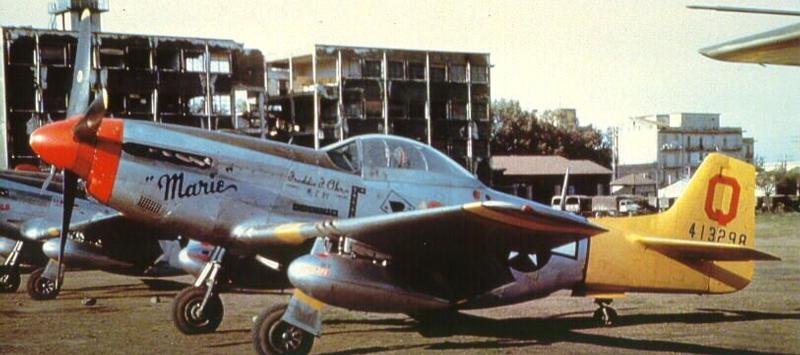 |
Home] [Nominal Roll 1940-45] [March Of The Gladiators] [Gladiators] [K Flight] [112 Sqdn Personnel] [Claims] [Bases 1939-1946 ] [Bill Barwick] [Plane Losses 1940 -45] [Prisoner of War] [In Memory of] [Operations Room Book] [ Log Book Extracts] [112 Plane Codes] [Memories] [Letters Home] [RAF Map Napoli 40/14] [[Allied Air Forces in MTO 1942/43]] [USAAF Honor Rolls 1942-1943 MTO] [US Dispatches] [Photos ]
